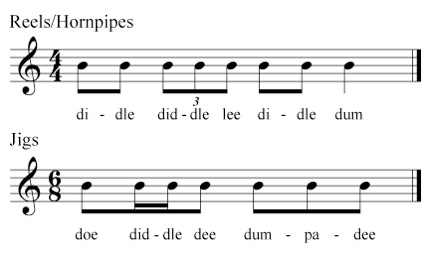
Irish Lilting
Lilting, known by a variety of names including diddling and mouth music, is the practice of singing dance tunes in Gaelic-speaking regions of Ireland and Scotland. In an effort to understand this technique and be able to teach it to my students I began to research the subject.
Although there are numerous references to this style of singing, informational resources are few and instructional materials are practically non existent. So I began to gather recordings and transcribe examples of lilting in an effort to develop my own understanding and instructional resources. This site is the result of my study which has included the transcription of more than fifty examples.
The origin of lilting is unclear, but it is an excellent way to learn and remember tunes, and a viable accompaniment for dancing if no instruments are available. For the purposes of this study I have focused more on Irish lilting than the Scottish puirt a beul which often uses more Gaelic language words, thus increasing the difficulty for learning and teaching.
The difficulties of transcribing this type of music are many, as can be expected with any music that has developed as part of an oral traditional.
Performances vary.
–Music learned orally is subject to personal recollection and interpretation.
–Repetition of tunes and sections within tunes allows for considerable
variation and ornamentation.
Pitch can be relative.
–By nature vocal performances tend to be less precise than instrumental
renditions.
–The key chosen by the lilter will be determined by the vocal range of the
individual. In transcription flat keys have not be used since Irish tunes are
typically performed in sharp keys, and excessive use of ledger lines outside
the staff has generally been avoided. If the pitch has been changed in
transcription, the original key is indicated.
–Tonal centers sometimes shift upwards as much as two semitones within a
performance.
–Melodic movement is at times so unstable as to make precise transcription
impossible.
The transcriptions have been simplified to provide a consensus of the pitches and syllables used in the various repetitions of the melody in the performance of the tune. Thus the audio excerpt and the corresponding transcription will likely exhibit differences.
One of my goals was to develop a glossary of syllables used in lilting and to determine if certain syllables tend to be associated with certain rhythms. Just as in the other aspects of the music, however, the syllables vary from person to person. The only evident consistency is the use by many lilters of the syllables diddle lee, or diddle dee, for quick rhythms such as triplets in reels and hornpipes, and sixteenth notes in jigs.

This is the first attempt I am aware of to put this kind of information in print. Some might criticize any effort to codify an oral tradition, but it is my hope that it will help to preserve the tradition. If an oral tradition ceases to be practiced, it can easily vanish within one generation. This is an effort to understand and disseminate the practice of lilting.
Your comments and suggestions are important to me. Feel free to contact me via email at tbaldridge@mnu.edu. You can learn more about me by visiting my personal website at http://www.tbaldridge.net/tbaldridge/.
Terry L. Baldridge, Ph.D.
Professor of Music
MidAmerica Nazarene University
Olathe, KS